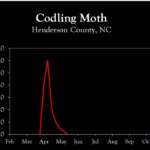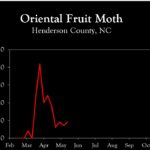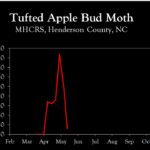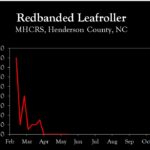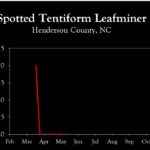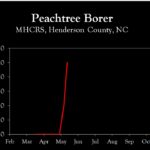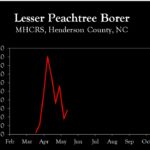WNC Orchard Insect Pest Populations – June 7, 2022
go.ncsu.edu/readext?868960
en Español / em Português
El inglés es el idioma de control de esta página. En la medida en que haya algún conflicto entre la traducción al inglés y la traducción, el inglés prevalece.
Al hacer clic en el enlace de traducción se activa un servicio de traducción gratuito para convertir la página al español. Al igual que con cualquier traducción por Internet, la conversión no es sensible al contexto y puede que no traduzca el texto en su significado original. NC State Extension no garantiza la exactitud del texto traducido. Por favor, tenga en cuenta que algunas aplicaciones y/o servicios pueden no funcionar como se espera cuando se traducen.
Português
Inglês é o idioma de controle desta página. Na medida que haja algum conflito entre o texto original em Inglês e a tradução, o Inglês prevalece.
Ao clicar no link de tradução, um serviço gratuito de tradução será ativado para converter a página para o Português. Como em qualquer tradução pela internet, a conversão não é sensivel ao contexto e pode não ocorrer a tradução para o significado orginal. O serviço de Extensão da Carolina do Norte (NC State Extension) não garante a exatidão do texto traduzido. Por favor, observe que algumas funções ou serviços podem não funcionar como esperado após a tradução.
English
English is the controlling language of this page. To the extent there is any conflict between the English text and the translation, English controls.
Clicking on the translation link activates a free translation service to convert the page to Spanish. As with any Internet translation, the conversion is not context-sensitive and may not translate the text to its original meaning. NC State Extension does not guarantee the accuracy of the translated text. Please note that some applications and/or services may not function as expected when translated.
Collapse ▲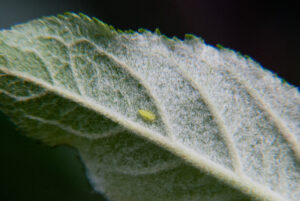 Codling Moth: In Henderson County and similar elevations, approximately 680 DD have accumulated, which is equivalent to about 50% egg hatch of the first generation. Hence, codling moth remains a potential threat and will be for another 10 days or so. At lower elevations such as Cleveland County, approximately 925 DD have accumulated since biofix, which coincides with about 75% egg hatch of the first generation. Hence, the first generation in nearly complete and there is a low threat of first generation damage at this time.
Codling Moth: In Henderson County and similar elevations, approximately 680 DD have accumulated, which is equivalent to about 50% egg hatch of the first generation. Hence, codling moth remains a potential threat and will be for another 10 days or so. At lower elevations such as Cleveland County, approximately 925 DD have accumulated since biofix, which coincides with about 75% egg hatch of the first generation. Hence, the first generation in nearly complete and there is a low threat of first generation damage at this time.
Tufted Apple Bud Moth: In Henderson County about 850 TABM degree days have accumulated since biofix, so we are now in the window where a single insecticide application will provide season-long control – provided an insecticide recommended for TABM is used (i.e., Intrepid, Delegate, Altacor, Exirel or Verdepryn).
Aphids, Leafhoppers and Mites: We are now approaching the time when these indirect pests traditionally begin to become problems on apples. At the research station we detected a few European red mites this week and potato leafhoppers. Green aphids were essentially non-existent, but they are not far off as plenty of winged aphids were present.
San Jose Scale was detected in several orchards in Polk and Cleveland Counties during the past week. Classic infestations on fruit (red spots) were quite apparent throughout orchards. Unfortunately, all of these orchards had been treated with a post bloom application of insecticide targeting scales. Historically, insecticide resistance in the San Jose scale is not common. In fact the only report in the literature in at least the last 25 years was resistance to Lorsban in apple orchards of Chile in 2015. It will be important to keep an eye on apples to detect infestations early so that chemical control can be applied in a timely manner. If Esteem or Centaur was used earlier, these should not be used as rescue treatments. Probably the most effective rescue treatment is Diazinon 50W (2-4 lbs/A), which can be difficult to source and has a 4-day REI, or Assail (5 to 8 oz/A). While Movento is an excellent product for scale, it is not quick-acting and often requires two applications.
Learn more about southeastern apple insect pests at the Apple Insect Management page.
2022 Average Weekly Trap Captures
| HENDERSON COUNTY | |||
| Insects per trap | |||
| May 23 | May 31 | Jun 6 | |
| Codling moth | 1.0 | 0.5 | 0.0 |
| Oriental fruit moth | 4.5 | 3.5 | 4.5 |
| Tufted apple bud moth | 42.0 | 24.0 | 3.0 |
| Redbanded leafroller | 0.0 | 0.0 | 0.0 |
| Obliquebanded leafroller | 6.0 | 4.0 | 1.0 |
| Lesser appleworm | 5.0 | 0.0 | 0.0 |
| Apple maggot (abandoned and research orchards) | – | – | set |
| Brown marmorated stink bug (commercial) | – | – | – |
| Brown marmorated stink bug (unsprayed) | 1.0 | 0.5 | 2.5 |
| Spotted tentiform leafminer | 0.0 | 0.0 | 0.0 |
| Dogwood borer | 80.0 | 82.0 | 54.0 |
| Peachtree borer | 0.0 | 2.0 | 5.0 |
| Lesser peachtree borer | 28.0 | 9.0 | 14.0 |
| San Jose scale | 0.0 | 0.0 | 0.0 |
| Ambrosia beetle (all species) | 6.3 | 3.0 | 0.8 |
*Note that these averages illustrate only the timing of insect emergence and fluctuations in populations, and are not representative of population levels in any given orchard. The only way to have an accurate assessment of an individual orchard’s populations is to set up traps in that orchard.
2022 Accumulated Degree Days
| HENDERSON COUNTY | ||||
| May 23 | May 31 | Jun 6 | ||
| Codling moth (Biofix: April 22) | 429 | 555 | 666 | |
| Oriental fruit moth (Biofix: April 12) | 686 | 852 | 994 | |
| Tufted apple bud moth (Biofix: April 27) | 488 | 655 | 796 | |



